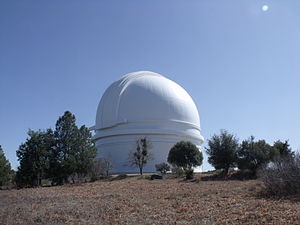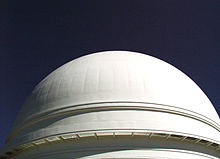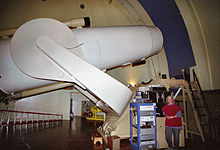- Palomar Observatory
-
Palomar Observatory Organization Caltech Location San Diego County, California CoordinatesAltitude 5,618 feet (1,712 m) Website
Palomar at CaltechTelescopesHale Telescope 200 inches (508 cm) reflector 60 inch Telescope 60 inches (152 cm) reflector Samuel Oschin Telescope 48 inches (122 cm) Schmidt Reflector JPL Palomar Testbed Interferometer Interferometer Palomar Observatory is a privately owned observatory located in San Diego County, California, 90 miles (140 km) southeast of Pasadena's Mount Wilson Observatory, in the Palomar Mountain Range. At approximately 5,570 feet (1,700 m) elevation, it is owned and operated by the California Institute of Technology. Research time is granted to Caltech and its research partners which includes the Jet Propulsion Laboratory, and Cornell University.[1]
The observatory includes several telescopes: the 200 in (5.1 m) Hale telescope, the 48 in (1.2 m) Samuel Oschin telescope (called the 48 inch Schmidt before 1986), and a 60 in (1.5 m) reflecting telescope. In addition, other instruments and projects have been hosted at the observatory, for example the Palomar Testbed Interferometer was active at the observatory from 1995 to 2009. Retired historical instruments include the 18 in (460 mm) Schmidt telescope, Palomar Observatory's first telescope, dating from 1936.
Hale's vision for large telescopes and Palomar Observatory
Astronomer George Ellery Hale, whose vision created the Palomar Observatory, built the world's largest telescope four times. He published an article in the April 1928 issue of Harper's Magazine called "The Possibilities of Large Telescopes". This article contained Hale's vision for building of what was to become the 200-inch Palomar reflector; it was an invitation to the American public to learn about how large telescopes could help answer questions relating to the fundamental nature of the universe. Hale hoped that the American people would understand and support his project. In fact the 200-inch telescope was the most important telescope in the world from 1949 until 1992 when the Keck I telescope (at approximately 10 meters - 387 inches) on Mauna Kea in Hawaii became the world's largest.
Hale followed this article with a letter to the International Education Board (later absorbed into the General Education Board) of the Rockefeller Foundation dated April 28, 1928, in which he requested funding for this project. In his letter, Hale stated:
"No method of advancing science is so productive as the development of new and more powerful instruments and methods of research. A larger telescope would not only furnish the necessary gain in light space-penetration and photographic resolving power, but permit the application of ideas and devices derived chiefly from the recent fundamental advances in physics and chemistry."
Etymology
The word palomar is from the Spanish language, dating back from the time of Spanish California, and means pigeon house (in the same sense as henhouse). The name may be in reference to the large shoals of pigeons that can be seen during the spring and autumn months atop Palomar Mountain or reminiscent of an old pigeon-raising facility built there by the Spaniards.[citation needed]
The Hale Telescope
The 200-inch (5.08 m) telescope is named after astronomer George Ellery Hale. It was built by Caltech with a 6 million dollar grant from the Rockefeller Foundation, using a Pyrex blank manufactured by Corning Glass Works. The telescope (the largest in the world at that time) saw first light January 26, 1949 targeting NGC 2261.[2] The American astronomer Edwin Powell Hubble, perhaps the most important observer of the 20th century, was given the honor of being the first astronomer to use the telescope.
Astronomers using the Hale Telescope have discovered distant objects at the edges of the known universe called quasars and have given us the first direct evidence of stars in distant galaxies. They have studied the structure and chemistry of intergalactic clouds leading to an understanding of the synthesis of elements in the universe and have discovered thousands of asteroids. A one-tenth-scale engineering model of the telescope at Corning Community College in Corning, New York, home of the Corning Glass Works (now Corning Incorporated) was used to discover at least one minor planet, (34419) Corning †
Architecture and design
According to the Observatory's Public Affairs Office, Russell W. Porter was primarily responsible for the striking Art Deco architecture of the Observatory's buildings, most notably the dome of the 200 inch Hale Telescope. Porter was also responsible for much of the technical design of the Hale Telescope and Schmidt Cameras, producing a series of remarkable cross-section engineering drawings that are considered among the finest examples of such work.[citation needed] Porter worked on the designs in collaboration with many engineers and Caltech committee members. The iconic, gleaming white building on Palomar Mountain that houses the 200 inch Hale Telescope is considered by many to be "The Cathedral of Astronomy".[citation needed]
Telescopes and instruments
Major instruments at the Palomar Observatory include:[3]
- 200-inch Hale Telescope (Project started in 1928, and active since first light in 1948) (see above)
- A 60" (1.5 m) f/8.75 telescope in the Oscar Mayer Building. It was dedicated in 1970 to take some of the load off of the Hale Telescope. This telescope discovered the first brown dwarf star.
- The 48" (1.22 m) Samuel Oschin Telescope (Schmidt Camera). The dwarf planet Eris was discovered by Caltech astronomer Mike Brown using this instrument. It was this object that triggered the discussions in the international astronomy community that led to Pluto being re-classified as a dwarf planet. It was formerly called the 48 inch Schmidt, and was named in 1986.[1]
- A 24" robotic telescope completed in January 2006. It is used to monitor the weather on Saturn's largest moon, Titan, and to follow up on observations of moving objects in the solar system discovered with the Samuel Oschin telescope.
- An 18" (0.4 m) Schmidt camera.[4] Now retired, in 1936 this became the first operational telescope at the Observatory. Comet Shoemaker-Levy 9 was discovered with this instrument in 1993. In the 1930s a Caltech astronomer named Fritz Zwicky discovered over 100 supernovae (exploding stars) in other galaxies with this telescope and gathered the first evidence for dark matter.
- The Palomar Planet Search Telescope From 2003 - 2008 this small robotic telescope was dedicated to the search for planets around other stars using the transit method.[5]
- The Palomar Testbed Interferometer a multi-telescope instrument that permits astronomers to make very high resolution measurements of the sizes and positions of objects in space. The shapes of some bright stars have been measured with the PTI.
Palomar Observatory sky surveys
The observatory has completed several observational survey series — the first in the 1950s, the second in the 1980s and 1990s, and a third in 2003.
POSS-I
The initial Palomar Observatory Sky Survey (POSS or POSS-I), sponsored by the National Geographic institute, was completed in 1958. The first plates were shot in November 1948 and the last in April 1958. This survey was performed using 14 inch2 or (6 degree)2 blue-sensitive (Kodak 103a-O) and red-sensitive (Kodak 103a-E) photographic plates on the 48 inch (1.22 m) Samuel Oschin Schmidt reflecting telescope. The survey covered the sky from a declination of +90 degrees (celestial north pole) to -27 degrees and all right ascensions and had a sensitivity to +22 magnitudes (about 1 million times fainter than the limit of human vision). A southern extension extending the sky coverage of the POSS to -33 degrees declination was shot in 1957 - 1958. The final POSS I consisted of 937 plate pairs.
Fritz Zwicky was the first astronomer to observe on Mt. Palomar and was the father of the Sky Survey Technique.[6]
Digitized Sky Survey (DSS) produced images which were based on the photographic data developed in the course of POSS-I.[7]
J.B. Whiteoak, an Australian radio astronomer, used the same instrument to broaden this POSS-I data further. Whiteoaks observations extended south to about -45 degrees declination, using the same field centers as the corresponding northern declination zones. Unlike POSS-I, the Whiteoak extension consisted only of red-sensitive (Kodak 103a-E) photographic plates.
POSS-II
The Second Palomar Observatory Sky Survey (POSS-II) was performed in the 1980s and 1990s that made use of better, faster films and an upgraded telescope. The Oschin Schmidt was given an achromatic corrector and provisions for autoguiding. Images were recorded in three wavelengths: blue (IIIaJ), red (IIIaF) and near infrared (IVN) plates, respectively. Observers on POSS II included C. Brewer, D. Griffiths, W. McKinley, D. Mendenhall, K. Rykoski, J. Phinney and Jean Mueller (who discovered over 100 supernovae by comparing the POSS I and POSS II plates). Ms Mueller also discovered several comets during the course of POSS II and the bright Comet Wilson 1986 was discovered by then graduate student C. Wilson early in the survey.[8]
Until the completion of the Two Micron All Sky Survey (2MASS), POSS-II was the most extensive wide-field sky survey ever. When completed, the Sloan Digital Sky Survey will surpass POSS-I and POSS-II in depth, although the POSS covers almost 2.5 times more area on the sky.
POSS-II also exists in digitized form (i.e., the photographic plates were scanned), both in photographic form as the Digitized Sky Survey (DSS)[9]
QUEST
The multi-year POSS projects were followed by the Palomar Quasar Equatorial Survey Team (QUEST) Variability survey.[10] This survey yielded results that were used by several projects, including the Near-Earth Asteroid Tracking project. Another program that used the QUEST results discovered 90377 Sedna on 14 November 2003, and around 40 Kuiper belt objects. Other programs that share the camera are Shri Kulkarni's search for gamma-ray bursts (this takes advantage of the automated telescope's ability to react as soon as a burst is seen and take a series of snapshots of the fading burst), Richard Ellis' search for supernovae to test whether the universe's expansion is accelerating or not, and S. George Djorgovski's quasar search.
The camera for the Palomar QUEST Survey was a mosaic of 112 Charge-coupled devices (CCDs) covering the whole (4 degree by 4 degree) field of view of the Schmidt telescope, the largest CCD mosaic used in an astronomical camera when built. This instrument was used to produce The Big Picture, the largest astronomical photograph ever produced.[11] The Big Picture is on display at Griffith Observatory.
Current research
Current research programs on the 200-inch Hale Telescope cover the range of the observable universe including studies on near-Earth asteroids, outer solar system planets, Kuiper Belt Objects, star formation, exoplanets,[12] gamma-ray bursts, black holes, quasars and much more.[13]
The 48-inch Samuel Oschin Schmidt Telescope is actively working on a new sky survey, the Palomar Transient Factory (PTF).[14]
The 60-inch telescope is used for a variety of projects including follow-up observations for the Palomar Transient Factory and is a rapid response telescope for gamma-ray bursts.
Clearest images
In September 2007, a team of astronomers from the United States and Britain released some of the clearest pictures ever taken of outer space. The pictures were obtained through the use of a new hybrid "Lucky imaging" and "adaptive optics" system which sharpens pictures taken from the Palomar Observatory. The resolution attained exceeds that of the Hubble Space Telescope by a factor of two.[15]
Directors
- Ira Sprague Bowen, 1948–1964
- Horace Welcome Babcock, 1964–1978
- Maarten Schmidt, 1978–1980
- Gerry Neugebauer, 1980–1994
- James Westphal, 1994–1997
- Wallace Leslie William Sargent, 1997–2000
- Richard Ellis, 2000–2006
- Shrinivas Kulkarni, 2006–
Public access
The Palomar Observatory is an active research facility. However, parts of it are open to the public during the day. Visitors can take self-guided tours of the 200-inch (5.08 m) telescope daily from 9 a.m. to 3 p.m. Guided tours of the 200-inch Hale Telescope dome and observing area are available Saturdays and Sundays from April through October. Details are available at the Observatory's web site, http://palomar-observatory.org. There is a visitor's center and a gift shop on the grounds. Behind-the-scenes tours for the public are offered through the community support group, Friends of Palomar support group. Periodic tours are also organized by the Reuben H. Fleet Science Center in San Diego.[16] The observatory is located off State Route 76 in northern San Diego County, California, is two hours' drive from downtown San Diego, and three hours' drive from central Los Angeles ( UCLA, LAX airport ).
In pop culture
The band Wellwater Conspiracy's 1997 debut album, Declaration of Conformity, contains a track entitled "Palomar Observatory." It is the last track on the album and completely instrumental. It is likely the track title was chosen by singer/drummer Matt Cameron, who grew up in San Diego near the observatory. Also, Canadian band The Rheostatics 11th track from their effort Whale Music is entitled Palomar. The song depicts a man named Palomar on the top of a mount, cleaning his lenses with saline waters. Palomar assembles his kaleidoscope in his lonely observatory. The song presents a visual characterization of a man on a mountain and his relationship with his best friend, a dog.
Palomar is mentioned in the first episode of season 2 of The X-Files, "Little Green Men". Fox Mulder refers to Hale's suggestion that an elf[17] crawled through his window and told him to build the observatory.
Selected works
- 1983 — Calvino, Italo. Palomar. Torino: G. Einaudi. 10-ISBN 8806056794/13-ISBN 9788806056797; OCLC 461880054 (Italian)
- 1987 — Preston, Richard. First Light. New York: Atlantic Monthly Press. 10-ISBN 0871132001/13-ISBN 9780871132000; OCLC 16004290
- 1994 — Florence, Ronald. The Perfect Machine. New York: HarperCollins. 10-ISBN 0060182059/13-ISBN 9780060182052; OCLC 611549937
Palomar Observatory and light pollution
Much of the surrounding region of Southern California has adopted shielded lighting to reduce the light pollution that would potentially affect the observatory.[18]
See also
- National Geographic Society - Palomar Observatory Sky Survey
- Mount Laguna Observatory
- Jet Propulsion Laboratory
- California Institute of Technology
- Digitized Sky Survey
Notes
- ^ Cornell University, Dept. of Astronomy: Palomar Observatory
- ^ "60th Anniversary of Hale Telescope," 365 Days of Astronomy (podcast). January 26, 2009.
- ^ Jet Propulsion Laboratory (JPL): Palomar Observatory
- ^ Palomar Observatory: 18-inch Schmidt Telescope
- ^ Palomar Observatory: Sleuth: the Palomar Planet Finder
- ^ Caltech did recognize Fritz Zwicky's sky survey pioneering work, however The Big Picture project failed to recognize his contribution to the sky survey technique in the introductory panel at the Griffith Observatory.
- ^ Minnesota Automated Plate Scanner (MAPS): MAPS catalogue; Mollise, Rod. (2006). The Urban Astronomer's Guide: a Walking tour of the Cosmos for City Sky Watchers, p. 238. at Google Books
- ^ Caltech: The Second Palomar Observatory Sky Survey (POSS-II)
- ^ NASA/Space Telescope Science Institute (STScI).: Multimission Archive at STScI (MAST)
- ^ Caltech press release: "New Sky Survey Begins at Palomar Observatory." July 29, 2003.
- ^ Caltech: "The Big Picture"
- ^ JPL: "Planet-Hunting Method Succeeds at Last." May 28, 2009.
- ^ Caltech: Hale Telescope Observing Runs
- ^ Caltech: Palomar Transient Factory (PTF)
- ^ Ghosh, Pallab. "'Clearest' images taken of space," BBC. September 3, 2007; University of Cambridge, Institute of Astronomy, Lucky Imaging website
- ^ Reuben H. Fleet Science Center: Palomar Observatory tour
- ^ Biography of George Ellery Hale at scienceworld.wolfram.com
- ^ International Dark-Sky Association (IDA): "Sky Glow Effect on Existing Large Telescopes", IDA Info #20.
References
- Crawford, David Livingston (1966). The Construction of large telescopes. London, New York: Academic Press. OCLC 1093049
- Mollise, Rod (2006). The Urban Astronomer's Guide: a Walking Tour of the Cosmos for City Sky Watchers. Berlin: Springer. http://books.google.com/books?id=Z0mvZk0s_TMC&pg=PA238&dq=palomar+observatory&cd=107#v=onepage&q=palomar%20observatory&f=false. 10-ISBN 1846282179/13-ISBN 9781846282171; 10-ISBN 1846282160/13-ISBN 9781846282164 OCLC 299995003
- Watterson, T.V. (1941). Palomar Observatory. San Diego, California: Frye & Smith.OCLC 6327013
External links
- Caltech Astronomy
- Palomar Skies, news and history written by Palomar public affairs coordinator Scott Kardel
- The SBO Palomar Sky Survey Prints
- "Palomar Observatory Weather". http://observatories.hodar.com/palomar/index.html. Retrieved December 2, 2006.
- Palomar Observatory Clear Sky Clock Forecast of observing conditions.
Categories:- Astronomical observatories in California
- Astronomy institutes and departments
- California Institute of Technology buildings and structures
- Domes
- Buildings and structures in San Diego County, California
Wikimedia Foundation. 2010.



